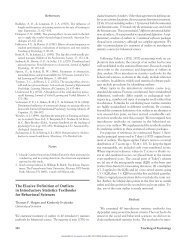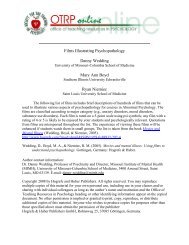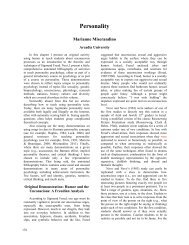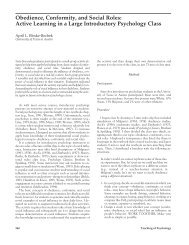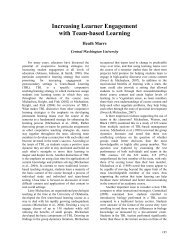INTRODUCTORY PSYCHOLOGY TEACHING PRIMER Early Career ...
INTRODUCTORY PSYCHOLOGY TEACHING PRIMER Early Career ...
INTRODUCTORY PSYCHOLOGY TEACHING PRIMER Early Career ...
You also want an ePaper? Increase the reach of your titles
YUMPU automatically turns print PDFs into web optimized ePapers that Google loves.
(In Class)<br />
The brain uses the information it receives to piece together a fairly accurate representation of the<br />
external world. One method the brain uses to make meaning from the sensations it receives is<br />
through algorithms and past experiences; similar to the way we solve cryptograms. There are a<br />
number of websites where students can try their hand at solving these puzzles, such as<br />
http://www.cryptograms.org/play.php or http://www.rinkworks.com/brainfood/p/crypts1.shtml.<br />
Students could either complete the same one or pick their own. Then have the class explain what<br />
rules of the English language they used, as well as what past experiences lead to the solution. This<br />
allows students to understand that the brain performs a similar task in perception. Students really<br />
enjoy this activity and it only takes a few minutes within a lecture. I use it to introduce perception.<br />
(LO 1.2)<br />
ACTIVITIES & TECHNIQUES<br />
(In Class)<br />
Explain the process of perception using the neural “algorithms” within the brain. (LO 1.2)<br />
Gestalt laws of organization:<br />
• These organizational processes can be explained nicely using real examples from<br />
art. Students like this way to present perception because they can relate to the art<br />
and many have prior knowledge of the pieces I choose.<br />
o Similarity-Anything from the technique of “Pointillism”<br />
Georges Seurat-“Sunday Afternoon on the Island of La Grande Jatte”<br />
o Proximity-Anything from the technique of Impressionism<br />
Monet-“Sunset in Venice”. The shadow of the church is a great example<br />
of proximity, as well as the refection of the sky in the water.<br />
o Closure<br />
Escher-“Sky and Water”, “Ribbon Faces”<br />
o Figure Ground<br />
Anything by Salvador Dali (e.g., “The Image Disappears”, “The Slave<br />
Market”<br />
o Good Continuation<br />
Anything having camouflage as a theme. Camouflage works because<br />
of the principle of good continuation. Usually photography is a great<br />
example -<br />
http://www.michaelbach.de/ot/fcs_face_in_beans/index.html<br />
Related Background Readings (instructors):<br />
• Verstegan, I. (2005). Arnheim, Gestalt, and Art, New York, NY:<br />
SpringerWeinNewYork. http://www.springerlink.com/content/978-3-211-28864-<br />
1/<br />
• Arnheim, R. (1943). Gestalt and art. The Journal of Aesthetics and Art Criticism, 2,<br />
71-75.<br />
• Solso, R. L. (2005). The psychology of art and the evolution of the conscious brain.<br />
Cambridge, MA: MIT Press.<br />
33






